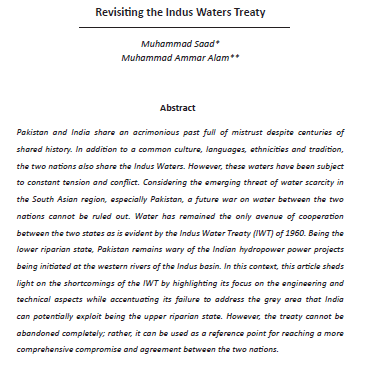Revisiting the Indus Waters Treaty
Abstract
Pakistan and India share an acrimonious past full of mistrust despite centuries of shared history. In addition to a common culture, languages, ethnicities and tradition, the two nations also share the Indus Waters. However, these waters have been subject to constant tension and conflict. Considering the emerging threat of water scarcity in the South Asian region, especially Pakistan, a future war on water between the two nations cannot be ruled out. Water has remained the only avenue of cooperation between the two states as is evident by the Indus Water Treaty (IWT) of 1960. Being the lower riparian state, Pakistan remains wary of the Indian hydropower power projects being initiated at the western rivers of the Indus basin. In this context, this article sheds light on the shortcomings of the IWT by highlighting its focus on the engineering and technical aspects while accentuating its failure to address the grey area that India can potentially exploit being the upper riparian state. However, the treaty cannot be abandoned completely; rather, it can be used as a reference point for reaching a more comprehensive compromise and agreement between the two nations.

Stratagem by Centre for Strategic and Contemporary Research is licensed under a Creative Commons Attribution 4.0 International License.



